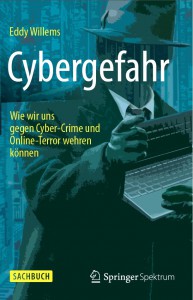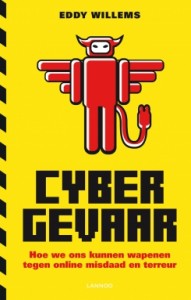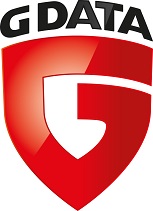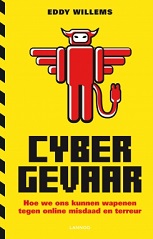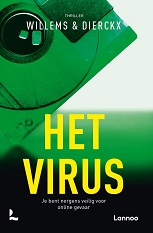Het Virus – My first SF Cyberthriller published
22 September 2020 together with co-author I published my first SF Cyberthriller ‘Het Virus’ . It’s a compelling thriller in Dutch about a very dangerous computer virus which will threaten the world like a biological pandemic.
“Utrecht, 13 February 2034. A self-driving car is hacked and disrupted, resulting in a fatal crash. NATO, which oversees global internet security, realizes that the world is in danger when two more attacks occur shortly thereafter. Europol inspector Lara Hartman and communications officer Frank Willems start a feverish manhunt for the perpetrators behind this awesome form of cyber terror. Everything seems to indicate a particularly dangerous computer virus. A race against time ensues to find an antivirus that can stop evil …”
For much more information have a look at the (Dutch) website of the book itself where you even can find the prequel of the story: www.hetvirus.com
My New Book ‘Cyberdanger’ Is Released: June 2019
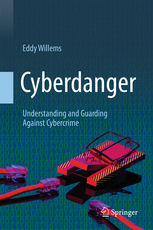
This book describes the key cybercrime threats facing individuals, businesses, and organizations in our online world. I first explain malware and its origins; I also describe the extensive underground economy and the various attacks that cybercriminals have developed, including malware, spam, and hacking; I also offer constructive advice on countermeasures for individuals and organizations; and I discuss the related topics of cyberespionage, cyberwarfare, hacktivism, and anti-malware organizations, and appropriate roles for the state and the media.
The book is important reading for all professionals engaged with securing information, people, and enterprises. It’s also a valuable introduction for the general reader who wants to learn about cybersecurity.
Blogging and other Information …
I started my website August 25 1995. It was and still is dedicated to cybersecurity. Honestly speaking I always wanted to help people and that was part of my way to deal with it. I started to blog September 2004 and I’m still doing it. However my blogs are divided up all over several websites since then.
You have a pretty good overview at my own website http://www.anti-malware.info also reachable via http://www.wavci.com at the ‘about’ and at the ‘blog’ pages.
You can find some of my very old blogs going back to 2004 at the following link http://eddywillems.blogspot.be/
Ubuntu on Windows 10: Good or Bad?
The good news?
Did you all hear the interesting news? During the last Microsoft’s Build developer conference (see https://build.microsoft.com/ ) Microsoft announced the latest tools and technologies and how they can help today’s developers be their most creative and productive. Besides a spectacular improved ‘Cortana’, an innovative HoloLens and a new update of Visual Studio, one specific fact came to us as an interesting surprise. Ubuntu is coming to Windows 10!
Actually it came from a secret project setup by Microsoft and Canonical and it was unveiled at Kevin Gallo’s opening keynote speech during the conference in March. (see https://blogs.windows.com/buildingapps/2016/03/30/windows-10-anniversary-sdk-is-bringing-exciting-opportunities-to-developers/ ) But the good news also has some security implications?
Cybergefahr – The German (and updated) version of my book Cybergevaar released!
Famous German publisher Springer launched ‘Cybergefahr’ in the D-A-CH countries, a book written by Eddy Willems, G DATA’s Security Evangelist.
This blog article was originally posted on the G DATA Security Blog and includes an interview with me.
As the boundaries between the real world and the virtual world become blurred, the Internet is turning into a stamping ground for cyber criminals. They are using targeted malicious activities to cause untold damage to private individuals, companies or even entire governments of a country. Internationally renowned security expert Eddy Willems has set himself the target of enlightening company managers, politicians, government representatives and end users to this – and not just in the IT sector. Once equipped with the necessary knowledge, readers of the Springer book on cyber threats are able to recognise dangers in the digital world and protect themselves against cyber attacks. The book does not presume any prior knowledge – whether the solutions needed are for PCs, smartphones or entire company networks.
“It would be nice if we could make the world a little bit safer and at the same time make life a little bit harder for cyber criminals with this book,” says Willems in his introduction to the book. However, no IT system is basically immune to these risks. Both Windows and Apple devices have become victims of malevolent malware. But in the opinion of the expert, professionals disagree as to when the first computer virus was actually born. Some say it was Creeper, the first worm in an experimental program dating from 1971. However, it might also be Elk Cloner, which was only recognised as a virus many years after it was discovered. The only certain thing, says Willems, is that “the distribution of malware initially took place at a snail’s pace, moving from computer to computer via diskette; but with the introduction of the worldwide web, things rapidly intensified in terms of speed and the number of cyber victims.”
This book is an updated and translated version of Willems’ original Dutch book ‘Cybergevaar’ (“Cyberdanger” in English), originally published by Lannoo, in October 2013, in Belgium and the Netherlands. “Writing a book about cyber threats in a comprehensible and comprehensive way is not an easy task, but the book ‘Cybergevaar ‘ succeeds in this”, certifies the book’s first review, conducted by a well-known Belgian IT magazine, Datanews. Another review by the known Virus Bulletin magazine is referencing it as ‘a pleasant read on an important subject’.
Internet of (Things) Trouble … the continuing story
Is the IoT industry making the same mistakes again?
The Car Industry
Especially all hacked cars made it into the latest newsflashes from online news media to the biggest media broadcasters in the world. Some examples were the Fiat Chrysler where 1.4 million cars were called back after the vendors Jeep hack and a Corvette where the brakes of the car could be remotely controlled. These examples confirmed the problems related to the whole car industry described in our former blog (e.g. The BMW problems).
The Fitness Industry
Completely different but fully related to the Internet of Things are the new wristbands, step counters or mobile fitness devices and the data they gather in-the-cloud and on the device and your smartphone. Interesting was the test performed by AV-Test, a worldwide well known independent test organization for security products. This test tried to measure how the private fitness data is transferred from the devices to the smartphones or the cloud and how secure the apps of fitness trackers are. You can find the full test here. These new fitness wristbands are very popular and it is already a trend; all activity results are recorded and analyzed in an app on the user’s smartphone. This means it is possible to immediately see how well the user performed. The question remains, however, is the data transported securely from the wristband to the user’s smartphone? Or is it possible for someone to intercept this link, copying or even manipulating the data? Or could the app itself be manipulated? Those questions were investigated, where 9 fitness wristbands or trackers together with the corresponding Android apps were monitored in live operation. How well performed those trackers in terms of security? And what about eavesdropping? (more…)
The AV community mourns for Klaus Brunnstein
The Viren-Test-Center’s founder passed away in May 2015, at the age of 77 (25/5/1937 – +19/5/2015).
A man we all will miss!
Klaus was one of the founders of CARO (the Computer Anti-Virus Research Organization), an organization that was established in 1990 to research and study malware. CARO was planning to create another official and public organization called EICAR, an organization aiming at antivirus research and improving development of security software. It was during the inaugural meeting of EICAR in Brussels, Belgium in 1991 that I’ve met Klaus for the first time.
While talking to Klaus, I got to learn about so many new aspects of viruses and that made me being even more interested in this whole matter. Some of his ideas were very controversial while some others, on the contrary, were even very conservative. His ideas inspired me in a lot of security related topics, events and publications I touched, visited and launched afterwards. At least you could say that, without Klaus and my first encounter with a Trojan horse, back in 1989, I wouldn’t have been into the security industry at all.
I still remember Klaus from his interesting discussions and points of view on a closed security forum. Actually, I still have all of his feedback in my backup system. Some of these old mails range back 19 years! I always stayed in contact with Klaus and I have met him during many security related events like the early EICAR conferences in the nineties.
During one of the latest CARO workshops, I told him about a book that I was writing and he told me that he always would be there in case I needed some advice. For that reason, I asked him, several months ago, to write an opinion chapter about the future of security for my book, called “Cyber Danger” (the German version “Cybergefahr” will be published later this year). I now do realize, that this will most probably be the last words he officially wrote in a book. Klaus will always be remembered as a pioneer. I am greatly saddened to have learned of his death yesterday. He contributed so much to the industry.
Klaus, I still owe you a copy of my book! Somewhere. Sometime.
Regin, an old but sophisticated cyber espionage toolkit platform
Malware can be named in one breath with Stuxnet & Co.
As G DATA experts worked on this rootkit for quite a while we also gathered some data. The first Regin version we identified was used in March 2009 and the compilation date is July 2008:
paul@gdata:~/regin$ ./pescanner.py b12c7d57507286bbbe36d7acf9b34c22c96606ffd904e3c23008399a4a50c047
Meta-data
================================================================================
File: b12c7d57507286bbbe36d7acf9b34c22c96606ffd904e3c23008399a4a50c047
Size: 12608 bytes
Type: PE32 executable (native) Intel 80386, for MS Windows
MD5: ffb0b9b5b610191051a7bdf0806e1e47
SHA1: 75a9af1e34dc0bb2f7fcde9d56b2503072ac35dd
ssdeep:
Date: 0x486CBA19 [Thu Jul 3 11:38:01 2008 UTC]
EP: 0x103d4 .text 0/4
Some sources go even back to 2003 but this in unclear at this moment however we can confirm that this campaign appeared at least early 2009.
An Open Source detection tool provided by G DATA
We identified the use of an encrypted virtual file system. In the version mentioned above, the file system is a fake .evt file in %System%\config. The header of the virtual file system is always the same:
typedef struct _HEADER {
uint16_t SectorSize;
uint16_t MaxSectorCount;
uint16_t MaxFileCount;
uint8_t FileTagLength;
uint16_t crc32custom;
}
During our analysis, the checksum was a CRC32. A generic approach to detect the infection could be a detection of the existence of a virtual file system on the infected system by checking the custom CRC32 value at the beginning of the file system.
Download the python script by going to the original G DATA article (link see below).
regin-detect.py SHA256: 98ac51088b7d8e3c3bb8fbca112290279a4d226b3609a583a735ecdbcd0d7045
regin-detect.py MD5: 743c7e4c6577df3d7e4391f1f5af4d65
And here is the output when a virtual file system is scanned:
paul@gdata:~regin$ ./tool.py security.evt
SectorSize: 1000
MaxSectorCount: 0500
MaxFileCount: 0500
FileTagLength: 10
CRC32custom: df979328
CRC of the file: df979328
Regin detected
Victims:
So far, victims of Regin were identified in 14 countries:
- Algeria
- Afghanistan
- Belgium
- Brazil
- Fiji
- Germany
- Iran
- India
- Indonesia
- Kiribati
- Malaysia
- Pakistan
- Russia
- Syria
Perhaps one of the most publicly known victims of Regin is Jean Jacques Quisquater, a well-known Belgian cryptographer. Kaspersky Lab stated this in their report which you can find at
securelist.com/blog/research/67741/regin-nation-state-ownage-of-gsm-networks/ .
Even more interesting is the fact that Regin seems to be the spyware behind the Belgacom case, a big Belgian Telecom provider hacked in 2013. Belgacom acknowledged the hack, but never provided details about the breach. Ronald Prins from Fox-IT, which helped with the forensics and investigation of the Belgacom case, confirmed on his Twitter page that Regin could possibly be the malware behind the Belgacom case.
The Intercept, a publication of First Look Media, not only connects Regin to Belgacom, but also names the European Union as potential victim in an article published on November 24th.
(more…)
The evolution of anti-virus solutions continues – Antivirus is not dead!
Anti-virus has evolved for the last 25 years and will continue to do so for the next 25 years
Actually, this is exactly what Alan Solomon wanted to point out: AV is and always will be in an evolving state. He showed that the future of anti-virus programs would evolve, from pure signature-based detection to different kinds of technologies like heuristics and behavioral detection and even to more advanced protection methods. And now, with targeted attacks (aka APTs) and nation-state spying as new players in the threat landscape, AV is making another step in its evolution.
AV solutions are an important layer in the defense for enterprises
So what is it about this time? A couple of days ago, it was Brian Dye, Senior Vice President of Information Security at Symantec, who has claimed that anti-virus is dead, during an interview with The Wall Street Journal. Unfortunately though, the headline “AV is dead” has the potential to be misinterpreted by a wide audience, if it is put in another context.
The statement was part of a description of Symantec’s product strategy for business customers. It is nothing new that AV-solutions are a baseline protection against common threats. They are established and therefore only play a minor role when it comes to outlining the strategic aspects of upcoming security solutions for dedicated attacks. And in the complex environment of a company network, a wide range of special protections are at charge. But Dye’s statement never meant to say that AV products are useless. He just said that it needs more than an AV product to protect a company’s IT infrastructure. And this is undoubtedly true. (more…)
IoT: The Internet of Things… ehm… Trouble?!
A balancing act between usability and security
The Internet of Things (IoT) gives everything an IP address so that everything can communicate with more or less anything and anyone else. The benefits and possibilities are almost infinite. But aren’t these technological developments evolving rapidly, maybe too rapidly? Smart TVs, gaming consoles, tablets, smartphones and cars can eavesdrop on us. Cameras in your laptop, smartphone and smart TV can watch us when we don’t want them to. Samsung is amending its user agreements to reassure people about the voice control on its smart TVs. BMW is rolling out a software update for the ConnectedDrive system in 2.2 million cars to prevent hackers easily being able to open the doors of the cars. These are the first signs that possibly too much has been started without reflection.
25 years with or within the Antivirus and Security Industry
Last week (9 December 2014) it was exactly 25 years ago one of my former managers gave me a diskette which appeared to be having the AIDS information trojan. At that time I was one of the first in the world to get a detection for it and who could reverse the situation from a trojanised machine back to healthy one. It changed my life completely. 2 years later I was one of the founders of EICAR. After that my whole life was dedicated to malware and security and I finally became what I always wanted to be: a Security Evangelist, actually a Cybersecurity Expert with deep knowledge of security and excellent skills to communicate technical stuff to non-technical people. If you want to refresh your memory about the AIDS Trojan you can watch my first TV interview (Dutch – VTM) from 9 December 1989 and find out that I changed a little bit.
I love what I’m doing. It’s my life and I’m one of the few which are not doing it only for the money. During those 25 years I’ve met a lot of interesting, brilliant minded and enthusiast people. The AV industry itself is also quite special and I still like to work with or inside this industry even after 30 years IT experience (not counting my university and school years). However some people involved are not always what they pretend to be and just do their job. It’s just a job for them.
It’s not a job for me, it’s much more, It’s my life.
And take it from me, there is a big difference if you’re driven by a mentality or principle to help the general public, companies and organizations in the continuous battle against cybercrime today.
I am ready for the next 25 years .. well that’s maybe a little bit exagerated. ;-)
PS: If you find less blogs from me these days over here just visit the blog page of G DATA or follow my Twitterfeed @EddyWillems or watch the media in your country.
Book Launch ‘Cybergevaar’
IT security Information for everybody
“Writing a book about cyber threats in a comprehensible and comprehensive way is not an easy task, but the book ‘Cybergevaar ‘ succeeds in this”, certifies the book’s first review, conducted by a well-known Belgian IT magazine, Datanews. The book “Cybergevaar” tries to provide a very readable and very accessible overview of almost every information security related problem and malware. It reaches out to the general audience and does not only target the technically savvy reader but provides information for everybody.
“Cybergevaar” starts with an overview of the history of malware and looks into the many profiles of malware writers and hackers. One of the chapters touches the topic underground economy and is using a lot of examples to explain the involvements. It is based on a whitepaper written by G Data SecurityLabs. Furthermore, new developments in the fields of cyber attacks, sabotage and espionage are discussed and looked into from different angles. The daily threats and the myths about malware are described in a detailed way. Among this, the chapter about general security tips and tricks is interesting for everybody. The book also provides a special chapter with thorough advice for companies.
While exploring the book, the reader can find several exciting security anecdotes and entertaining situations one possibly has never heard of before. Additional clarifications are provided throughout the entire book by use of attractive illustrations and easy-to-understand graphs. High-level opinions of people with experience and interest in the ICT security industry are included: Professionals such as Natalya Kasperskaya (InfoWatch), Ralf Benzmüller (G Data), Peter Kruse (CSIS Security Group), Bob Burls (Independent IT Security Consultant) are amongst the contributors. The book also seeks to elaborate on how governments and the media can play a role in the ‘education’ of users. Moreover, it gives an inside look into the computer security industry and organizations like AMTSO and EICAR. And, of course, ‘Cybergevaar’ does not miss the opportunity to highlight how the problem and its solutions may develop in the future, with a special chapter in the form of a short story – ‘Radical Ransom’ – set in the year 2033.
“Cybergevaar” by Eddy Willems, Lannoo, 213 pages, is now available in Belgian and Dutch bookstores and online shops. Plans to publish this book in other languages, such as German and English, are currently being discussed.
Official Website (Dutch): www.cybergevaar.be and www.cybergevaar.nl
You can also order your version of the book via this webpage: www.lannooshop.com/gdata
Cold Cyber War
About the abuse of sensational catchwords
When I think of the word ‘war’, I think of a situation where two or more sides attack one another. And the attacks lead to casualties. This should also be the case in a so called cyber war. And something like that, has not yet been seen. And quite frankly, I don’t think we will see one materializing soon.
Happy New malware Year
A turbulent beginning of 2013
We can determine threats on two major fronts: Ruby on Rails, Java and Microsoft’s Internet Explorer form the first one – all web-related. And then there are flaws in Foxit Reader and Microsoft’s Windows RT, which also got in the line of fire.
Make updates! Restart your computer!
Pornography alarm or reboot?
But there is another pitfall: Most computer users do not realize that many software updates do not only need to be installed, but the computer needs to be restarted for the updates and patches to take effect. The combination of ignorance, impatience and laziness is fatal in this sense.
The safety of the PC stands and falls with the combination of your security software, the updates of the OS and other software and especially of your own behavior. Very often, the Achilles heel of PC security is human ‘procrastination’.
Users often don’t want to turn the PC or laptop off completely, because the startup takes too long. The endlessly used method to simply closing the laptop or choosing hibernation state of the PC is a phenomenon that most readers will be familiar with. The use of tablet computers even made it worse: those devices are ready to be used in an instant and therefore have made us even more impatient.
(more…)
Windows 8: Malware-free?
We always loved Microsoft’s operating systems as most of them are adopted very well in the whole world and security has been improving since years. The new incarnation of Windows 8 is somewhat different to the former ones as the interface underwent some notably big changes.
Windows 8 offers the same interface on many devices: Xbox, via desktop to tablet PCs and smart phones. Microsoft tries to make a user experience that is almost universal. Nevertheless, it appears that the app functionalities under Windows RT (the one for ARM tablets) and the program of the desktop version are not always the same.
You might think that having a very similar interface on the different devices enables you to do the same things on different hardware, but that doesn’t seem to be true in all the cases. Sometimes, the decision to change the user experience and the usability is a matter of security, and that is to be welcomed, but all in all, it creates confusion for the user.
A good example is Skype, from Microsoft. You can use it on any Windows device, but it is impossible to send over files under Windows RT – most possibly because of the security restrictions, due to the sandboxing approach. That is an ambiguous feature, from a user’s point of view. And that’s not the only critical view we have.
The AVAR conference 2012 in Hangzhou, China
IT security specialists discuss and shape their industry’s future
This year’s AVAR Conference is covering a lot of trending topics ranging from mobile malware to botnets. Seji Murakami, Chairman of AVAR, traditionally opened the conference with a warm welcome speech. This year, the keynote speeches were focused on Android security product testing (AV-Test), preventive actions concerning malware in China (CERT China) and malware trends (Microsoft).
IT security specialists now gathered for the 15th edition of the conference and it always tried to highlight the specific problems related to Asian malware. One of the main topics over here is “working all together against cybercrime” which is, unfortunately, not always an easy thing to do.
If you are interested in the agenda and information about the other topics discussed, you can find a lot of information on the AVAR Conference 2012 website. Furthermore, more info about the next conference’s venue and future topics will also follow on the official AVAR homepage.
This article can be found also on the G Data Blog.
The lack of basic security and good consultancy in a world dominated by an economical crisis
Why basic antivirus is not failing.
So, several companies and the general public were claiming that we all were too late in stopping these threats. Looking at the case of Flame the AV industry found out that we already had some samples of it when the news became public, but we were not aware of it. The samples have never been verified as being malicious before. Also Stuxnet went undetected for over a year after it was found.
So, the question might be the following: Is the anti-virus industry ready for the next battle? Can we all, with our tight consumer antivirus industry related budgets, be up against targeted malware or APT’s created by organizations with a lot of money?
This website is 17 years old!
Back in 1995 at the end of August I started this website as one of the first anti-virus and security sites in the world. Today I nearly forgot this anniversary. The reason for this is that the speed of news and amounts of malware related problems has been growing like hell. The amounts of data and malware we see these days are excessive. I am personally involved with all this stuff much more (24/24 7 days a week) these days compared to 1989 when it all started for me. The hacks we see these days are worrying. The mentality of people seems to be changed dramatically and hacking (read ‘cracking’) seems to be as normal as having dinner these days. Cyberwarfare, cybersabotage and cyberespionage are now also part of the problem. I wish I could say over 17 years: ‘Yes we’ve done it, we (the AV and security industry) solved the malware problem’ but I’m now sure that this is probably wishful thinking and never will be the case. However this battle isn’t over yet. Malware writers, hackers and other cybercriminals be prepared that also the laws are changing, maybe you could start thinking about finally turning you’re skills into the good direction. I hope nations will think twice when writing nation-state driven malware or even thinking of hacking back the hackers. An eye for an eye makes the whole world blind (Mahatma Gandhi).
Three importants AV industry events in a row
EICAR
While the EICAR conference 2011 was dominated by the buzzword cyberwar, the 2012 EICAR conference, actually the 21st, was focusing on ‘Cyber Attacks – Myths and Reality in Contemporary Context’. The conference took place at the Marriott Hotel in Lisbon.
The recent past brought a considerable shift in the underground malware authors’ mentality; a swing from the thrill-seeking geek striving for flame or glory to the professional culprit methodologies and, even more importantly, the inadequate expertise of the average user, for monetary gain. The next contemporary threat scenario calls for an adaptation of the technology and the defense methodologies. Even if scientific research would provide the baseline for some innovations, we still need to have a more holistic approach on the implementation of new innovations. This conference therefore invited researchers to address some of these issues in their papers.
This year’s event was another great one and we are already looking forward to the next one, including some new initiatives from EICAR which should appear soon on the EICAR’s website. If things turn out as planned, the EICAR 2013 conference will be held in Cologne, Germany, 9-11 June 2013. (more…)
Several important events in one month
4 fruitful meetings and thriving events: G Data at AMTSO, RSA , CeBIT and Infosecurity Belgium
The end of February and March have always been dedicated to several traditionally important security industry events of the year. This year, it started with an AMTSO Meeting and was followed by the RSA conference, the biggest IT security conference in the US, in the beautiful city of San Francisco. CeBIT, is still one of the most important events in the world for the digital industry, held in Hannover, Germany. The RSA conference and CeBIT traditionally have a lot of other, minor security related meetings where we also participated in.
The good and the bad about AV multi scanner services
Online AV multi scanners are used quite often these days. However, not every user is aware of these sites and what their possibilities and limits are. Using the public online multi scanner services can be useful, but the analysis results don’t allow straightforward conclusions.
It is common for malware samples to remain undetectable for hours or even days. G Data has got comprehensive and fast detection rates for malware through our cloud technology. But still, some users might want to know more about a particular suspicious file or even analyze it themselves.
One of the easiest ways to accumulate a minimum of the desired information is provided by using online AV multi scanners. There is an interesting concept behind that: when you found a suspicious file on your pc, you can easily upload it to the service and have an immediate result as the file itself will be scanned with various up to date virus scan engines. This principle has been around for years now and gives you some immediate insight into a suspicious file. And there are indeed several of these scan service sites around. The most popular possibly is VirusTotal but you have several other ones like Jotti, NoVirusThanks, Metascan or Virscan, to name only some of them.
How does it work?
Let’s have a look at one of the most popular services, VirusTotal. You can submit your sample on a website but you could also use an email submission feature – whatever suits your needs. Online, you can even use some hash value searching, meaning that you can search their existing database of scanned files based on a sha1, sha256 or md5 hash. This feature is handy if you don’t have an actual file but know the hash value of it.
Bug bounty initiatives: a summer approach against cyberthreats?
(This blog article has been published at the G Data Security Blog over here.)
The summer season has always been a mixture of holidays and launching new intiatives against cyberthreats if you look back at the past months. One of the new initiatives is brought to us by Microsoft with what they call the Blue Hat Prize. It is a contest that wants to generate new defensive approaches in the field of computer security. By launching this initiative, MS wants to develop new solutions to resolve security threats. And there are interesting prizes for the participants, ranging from $10,000 to $200,000.
It is known that MS also has some internal research conferences, but this new program will focus on new technology and defense against memory safety vulnerabilities especially. Microsoft clearly wants to encourage researchers to think about new ways of defeating entire classes of bugs instead of MS paying for individual bugs only, like some other companies are doing.
Mobile and in-the-cloud OSes: Moving to the cloud, moving to different threats?
Lots of companies and home users “have their head in the clouds” moving their services, servers and data to the cloud without realizing they are using the cloud since a decade already and they have never given any thought about security of using services from the cloud. Even now, with financial incentives, they do not consider or look at the security implications at all.
Where does a network stop these days? Where does the business network stop? This is not easily definable anymore. Today, networks lacks clear crisp boundaries and it becomes more and more difficult to define what the real inside and outside of the corporate network is. It even becomes more and more difficult for normal users to protect themselves and to detect the real risks behind every part of the network.


